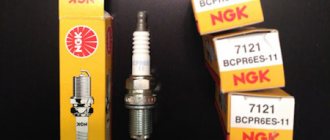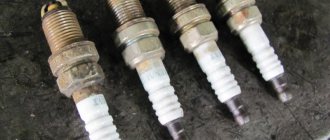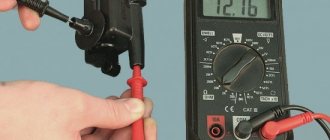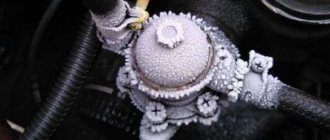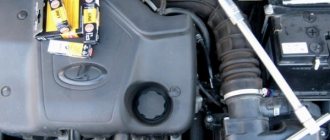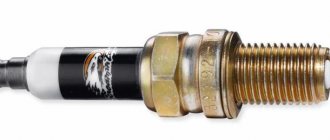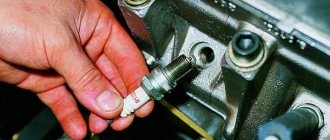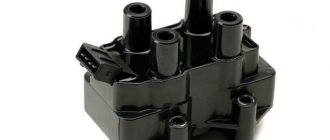How to choose spark plugs
In the past, drivers did not think about what kind of spark plugs they should have, they simply purchased the only spare parts available in stores, which were used both on domestic cars and on the first foreign cars that appeared on our roads in the nineties of the last century. Today, technology has stepped far forward; spark plugs have appeared with several electrodes at once, made of sputtered noble metals, which differ in their heat rating, the material of the central electrode and a number of other parameters.
It is not surprising that with all this variety of choice, many car owners have difficulty choosing the model that will be optimal for a particular car. In such a case, it is necessary to take into account not only the rating of the best spark plugs, but also familiarize yourself with the recommendations of the car manufacturer. The technical documentation of the car usually indicates what heat rating and other parameters of the spark plugs are suitable for a particular engine.
If you are thinking about which spark plugs are best for your car, then you must also take into account not only the technical requirements of a particular engine, but also the cost of specific models. Multi-electrode spark plugs with central electrodes made of platinum or iridium and other noble materials have an extended service life, but at the same time they are characterized by a high cost, which not all car owners can afford.
Types of spark plugs according to the material of the central electrode
To determine which spark plugs to install on your car, you need to study information about their features, and, in particular, the type of spark plugs based on their electrode material. This is perhaps the main parameter on which the price of a particular model, heat rating indicators and the possibility of using them on a particular car will depend. Inexpensive models in which the central electrode is made of iron, nickel, copper or zinc dissipate heat well and have excellent electrical conductivity. However, in the cold season with such spark plugs it is significantly difficult to start the engine; nickel models can be filled with fuel in the cold season, and their service life usually does not exceed 20-25 thousand kilometers.
The rating of spark plugs for cars today is invariably topped by models whose central electrode is made of various noble metals, including platinum, iridium or silver. Such spark plugs are made using a special technology with a thin electrode, which not only provides high spark power, but also prevents them from being flooded with fuel. Accordingly, reliable engine starting is ensured in almost any conditions. The service life of such models is much longer than that of conventional spark plugs; for example, iridium ones last 50,000 kilometers, and platinum ones - up to 100 thousand kilometers.
Nickel
Nickel spark plugs are the simplest models in which the side and central electrodes are made of nickel. Despite their affordable price, such spark plugs can last even up to 50,000 kilometers, and they are approved for use not only on foreign cars that were produced ten years ago, but even on completely new business-class cars. The advantage of such models is their versatility of use, good service life, excellent heat rating characteristics, as well as their affordable cost.
Platinum
A distinctive feature of platinum spark plugs is the presence on the central electrode of a platinum solder at a sharp tip. This noble metal has excellent performance characteristics, allowing the production of thin electrodes, which is necessary for their long service life. Typically, the resource of such spark plugs is 60-70 thousand kilometers. Such models are often included in the top 15 spark plugs for modern cars, due to their excellent performance characteristics.
Iridium
Iridium spark plugs are made using a special technology with a central electrode made of iridium and soldering on the side electrode made of platinum. This design provides not only excellent performance characteristics, a high-quality and stable spark, but also a long service life, which is about 100,000 kilometers. Such models invariably top the list of top 15 spark plugs, which is explained by their excellent performance during operation. The only drawback of iridium spark plugs is their high cost, which is several times higher than the price of similar inexpensive nickel models.
Types of spark plugs by number of contacts
Experts who give recommendations on how to choose spark plugs first of all advise deciding on the number of contacts for the desired spark plugs. The simplest single-contact models have a short service life; they are suitable for foreign cars produced several decades ago and simple domestic cars.
The rating of spark plugs for 2020 is invariably led by multi-electrode models, which, thanks to their complex design, make it possible to provide a high-quality spark necessary for stable ignition of the fuel-air mixture. Their only drawback is their high cost, which slightly increases the costs of car owners.
Single contact
Single-pin spark plugs have been popular in the past due to their simplicity of design. If you are thinking about which spark plugs are best for a used foreign car produced more than ten years ago, then single-pin simple spark plug models will be the optimal choice in such a case. Their advantage is not only their affordable cost, but also the ability to use it with low-quality gasoline.
Two-pin
Two-prong spark plugs have several side electrodes, which guarantees a stable, powerful spark necessary for proper ignition of the fuel mixture. This multi-electrode configuration extends the life of the spark plugs, positively affecting their reliability. However, today such candles are not used so often, which is explained by their high cost. If you are thinking about which spark plugs to choose, then you should first of all pay attention to the material of the central electrode, and not to the number of its contacts.
Three-pin
Three-pin spark plugs provide a consistent spark and are most often used on premium cars today. The technical documentation for such cars indicates which spark plugs are best installed on the car. When using such spark plugs, it is necessary to remember that increased demands are placed on the quality of gasoline, which will ensure the correct operation of the power unit.
Prechamber
You can also find expensive plasma prechamber candles on sale, which have a different design from standard models. A feature of this technology is the preliminary ignition of a small amount of fuel, which is subsequently supplied to the engine in a burning form.
According to the manufacturers of such spark plugs, their use makes it possible to slightly increase engine power while ensuring fuel economy. However, numerous tests carried out did not allow us to establish any advantages of such pre-chamber candles, while their cost is an order of magnitude higher than standard models.
Characteristics of NGK spark plugs, differences by type
When to change spark plugs correctly
Let's start with the fact that each candle manufacturer offers the consumer unique features that are achieved during the production process. NGK is no exception. Although the design of products of this kind has long been a well-thought-out and virtually complete solution (does not involve fundamental differences), manufacturers regularly improve various characteristics.
These improvements are made possible by minor modifications to the overall design and also result from the use of new materials. In combination with a high-tech manufacturing process and subsequent test checks, the percentage of defects in each individual batch is significantly reduced, and the service life of NGK spark plugs from each series is increased.
As for the types of candles themselves, the company offers 7 types of products. Each type has different unique characteristics and features. For example, NGK spark plugs from the V-Line line are a popular and affordable solution. Such products are capable of ensuring smooth operation of the internal combustion engine even in conditions of a very lean working mixture.
Stable spark formation allows for timely and complete ignition of the fuel charge in the combustion chamber. At the same time, maximum reliability is achieved in different engine operating modes (ease of starting, driving at low speeds, maximum loads, transition mode, etc.).
NGK's simple single-electrode spark plugs are stable during operation thanks to a special V-shaped notch on the central electrode. This solution allows the potentials to be distributed closer to the periphery.
In this area, as a rule, the highest concentration of fuel vapor is observed. As a result, a powerful spark allows for efficient and complete ignition of the charge throughout the entire service life of the spark plug (about 30 thousand km).
Also among the various types of NGK spark plugs, options with multiple electrodes are widely available. Multi-electrode spark plugs are a more modern solution and are characterized by increased reliability. Several side electrodes provide stable sparking even if one of them fails.
At the same time, the quality of ignition of the lean mixture improves, the spark plug works stably in different modes. Depending on the number of side electrodes on the spark plug, there can be from 2 to 4. The elements are located around the central electrode at an equal distance from each other.
The advantages of this type of product include a lower tendency to become dirty, as well as a noticeable increase in service life (about 50 thousand km). Moreover, high quality has become the reason for individual developments. For example, three-electrode spark plugs NLC were developed specifically for engines of the German auto giant VAG.
Spark plugs with a cone-shaped central electrode and special solderings that are made on the inner surface of the side electrode also deserve special attention in the general catalog. These solderings are alloys based on rare earth metals (platinum, iridium).
Such metals can significantly increase the service life of spark plugs (on average, up to 3 times compared to conventional single-electrode ones, and also by 30-40% compared to multi-electrode ones). Due to their long service life (about 80-100 thousand km) and reliability, NGK iridium spark plugs are enviably popular among car enthusiasts.
How to change spark plugs
When operating a car, the car owner will invariably need to replace spark plugs, which can be done either himself or contact specialized workshops. First of all, you need to decide which spark plugs are suitable for a particular car and purchase high-quality and original models. The ability to carry out such work independently will largely depend on the design and features of the engine.
Correctly replacing spark plugs can only be done on vehicles that have easy access to them from the top or side. In such a case, all that is needed is a special wrench that is used to unscrew the spark plugs from deep planting wells. You will first need to disconnect the high-voltage wires and remove the coils. After replacing the spark plugs, the entire ignition system is reassembled in the reverse order.
Unfortunately, today many modern car engines have a complex design, so replacing spark plugs on them yourself can be problematic. In such a case, it is necessary to contact specialized service stations, and the cost of such work can be quite high. The service technicians will not only tell you which spark plugs to put on the car, but will also be able to quickly carry out all the necessary repair work.
Plasma coronas, controlled combustion, ionization... It sounds like something from a sci-fi action movie, but in fact we are not talking about science fiction, but about the latest invention that promises to reduce fuel consumption and displace conventional spark plugs
, since at one time they replaced the magneto.
The device you see in the picture is the latest technology in the field of ignition and, according to its creators at Federal-Mogul, will soon take over the job that traditional spark plugs do. It was called ACIS, which stands for Advanced Corona Ignition System.
. The most important thing about this technology is to reduce fuel consumption by at least 10%. Moreover, if Federal-Mogul's development takes off, it has the potential to give engine designers the opportunity to make their engines even more advanced.
How it works
When using conventional spark plugs, the mixture ignites pointwise - combustion spreads from the spark, the gases expand, accelerating the downward movement of the piston. The main difference between the operation of ACIS is that instead of a point spark, ignition occurs over a larger area - in the form of a crown
.
This ionizes and excites the fuel mixture in the combustion chamber, which initiates faster and more efficient ignition over a larger area.
Regular candle and ACIS. Photo: Autocar
Using extremely hot plasma as a source means ACIS is capable of igniting a significantly less flammable mixture, similar to those used in more fuel-efficient lean-burn engines using exhaust gas recirculation.
Fast and bright
The corona doesn't last long, but its intensity is extremely high—"a typical spark lasts for two or three milliseconds," says Christopher Mixel, director of Federal-Mogul's Transmissions and Powertrain Division, "while the corona lasts about 100 to 200 microseconds." But, unlike a point spark, the diameter of the crown can reach 30 or 40 mm. This initiates rapid, extensive and uniform combustion of the mixture throughout the chamber. According to Mikesel, this not only allows us to talk about fuel savings now, but also suggests that new configurations of more efficient combustion chambers can be developed based on this technology.
The diameter of the crown can reach 30 or 40 mm. Photo: Autocar
Running "skinny"
But even with existing internal combustion engine designs, the benefits are obvious. When using ACIS, the air-fuel mixture burns faster, so the energy of the expanding gases is used more fully in the engine operating cycle. This also means the engine can run leaner and be more fuel efficient.
... And the launch is clean
Exhaust gas recirculation (EGR), in which part of the exhaust gases are returned and entered into the air-fuel mixture to reduce nitrogen oxide emissions, is one of the favorite tricks of modern engine developers. Exhaust gas recirculation slows the combustion rate of the mixture and helps absorb any unburned hydrocarbons that remain in the exhaust gases. Using EGR also reduces the need for a rich jet of fuel to achieve a crisp throttle response.
However, exhaust gas recirculation systems can make it difficult for the mixture to ignite. And this problem is successfully overcome by ACIS. An engine with ACIS can operate with a higher volume of exhaust gas recirculation, making it cleaner and more efficient.
Detonation
ACIS can also reduce the likelihood of detonation, which occurs when the air-fuel mixture is ignited by pressure, similar to what happens in a diesel engine. The result of detonation can be damage to the connecting rod and piston group. But ACIS burns the mixture faster and over a larger area in a more “controlled” manner, eliminating the chance of detonation.
Compression
All of the above also means that engines equipped with ACIS can run at higher compression ratios. Increasing it is a long-known way to increase the efficiency of internal combustion engines, but it was the problem of detonation that until now has prevented the increase in this indicator.
According to Christopher Mikesel, the compression ratio in an engine with ACIS can reach 14:01 in a naturally aspirated engine or 12:01 in a turbocharged internal combustion engine. At the same time, ACIS spark plugs will have a longer service life due to the absence of corrosion of the electrodes.
What's next?
ACIS is currently in the research and development stage.
Federal Mogul says the work is being done in partnership with several automakers (Mazda, however, is not one of them, even though its new SkyActiv gasoline engine already operates with a compression ratio of 14:01.) The system is specifically designed this way . such that the ACIS unit can be screwed into standard spark plug threads so that the system can be used on existing engines. While this is not part of Federal-Mogul's vision, there is some possibility of ACIS appearing on the aftermarket.
Rating of spark plug manufacturers
If you don’t know how to choose spark plugs, then an excellent solution to this problem would be to use various ratings that contain the best models suitable for both new foreign cars and cars with high mileage. These tops include not only expensive models of spark plugs from leading manufacturers, but also options designed for their installation on AvtoVAZ products and well-worn inexpensive foreign cars. Based on this rating of spark plugs, you can make the right choice, permanently solving the problem with the operation of the ignition in the engine.
Denso
Denso is a large Japanese spark plug manufacturer. The offer of this brand includes models for both the business and premium segments, as well as for economy class foreign cars.
Denso products regularly rank among the top manufacturers of spark plugs, which is explained by unsurpassed quality, high-tech products and the longest service life of spark plugs. Denso spark plugs with nickel electrodes are very popular, which ensure excellent engine starting even in severe frost.
NGK
A feature of spark plugs from the Japanese manufacturer NGK is stable sparking and prevention of the appearance of chemical deposits on the electrodes. In the NZhK company's product line you can find spark plugs intended, among other things, for engines running on gas.
Models with iridium electrodes, which are characterized by excellent durability and workmanship, are popular. They invariably rank among the top spark plugs for premium cars, having a service life of 80 thousand kilometers or more.
BRISK
Brisk is a Czech manufacturer of spark plugs, whose product line includes dozens of different models designed for naturally aspirated or turbocharged engines, cars with forced engines and those running on gas.
The use of special technology allows for rapid and complete ignition of the fuel-air mixture, reducing the engine's consumption of gasoline. The ranking of spark plug manufacturers invariably includes the Czech brand Brisk, whose products have proven themselves well over many decades.
Bosch
Bosch is a well-known German brand that offers its customers high-tech products at affordable prices. Such spark plugs ensure stable engine operation even at minimum battery voltage. Single and multi-contact models make it possible to obtain a plasma spark arc, which is one of the prerequisites for complete combustion of fuel, increasing engine power and reducing gasoline consumption.
Bosch products are often included in the rating of iridium spark plugs; this manufacturer specializes in the production of spare parts that are characterized by excellent durability.
Finwhale
Swiss manufacturer Finwhale offers two lines of F-series spark plugs with galvanic coating and highly ductile steel electrodes, as well as FS models, which use a copper core.
Finval brand products belong to the economy segment and have an affordable price, but one cannot expect excellent quality or a record long service life from them. Worn spark plugs can fail in low temperatures and under heavy load, which leads to problems with starting the engine.
Torch
Until the recent past, Chinese auto parts manufacturers did not have a very good reputation, so most car owners preferred not to deal with such brands. However, the Torch company offers consistently high-quality products, including spark plugs with iridium and platinum electrodes.
On average, the service life of Torch spark plugs is 20 thousand kilometers, after which problems may arise with starting the engine in the cold season, or the spark plugs no longer produce a high-quality spark and require replacement.
BERU
If you are thinking about what spark plugs to buy, we can recommend that you pay attention to the products of the German manufacturer BERU. Its offer includes three series, which are intended for gasoline engines and engines running on natural gas.
The advantages of the products of this brand include a stable spark in conditions of significant contamination of the electrode, excellent workmanship and affordable cost. Today, Beru candles are invariably popular with customers who appreciate their reliability and excellent performance characteristics.
Champion
Champion is an American manufacturer of spark plugs whose products are highly technologically advanced, providing the necessary fuel economy over a wide range of engine speeds. Many American manufacturers recommend using Champion brand spark plugs on their cars.
You can obtain the necessary technical information and find out what spark plugs are needed for your car from the documentation for the car. This brand's offer includes spark plugs with iron, platinum and iridium electrode coating, which differ in their heat rating and a number of other parameters.
EYQUEM
The French manufacturer EYQUEM was founded back in 1886. One of its activities is the production of spark plugs, which today are successfully used by many European manufacturers, including those installed on Audi and Volkswagen, BMW, Mercedes, Peugeot, Volvo and others. Certain lines of this brand invariably fall into the top of the best spark plugs; ultra-modern technologies are used for their production, including soldering of electrodes made of rare earth metals, which can significantly extend the service life of such parts.
Motorcraft
Motorcraft is a division of the American company Ford, which specializes in the manufacture of automobile parts. Motocraft spark plugs are installed on Ford, Lincoln, Mercury and other cars. The advantages of such models include their affordable cost, excellent build quality, reliability and durability. These are simple and inexpensive spark plugs that will faithfully last about 20-30 thousand kilometers.
EZ
EZ spark plugs are products of the Boshev plant located in Russia in the city of Engels. Such spark plugs are recommended for AvtoVAZ cars; they are factory installed on various models of Ford, Chevrolet, Renault, Mitsubishi, Nissan and other brands. The advantages of the offer of this Russian brand include its good quality of spark plugs, the presence of various models in the product line, which allows you to select such spare parts for domestic cars, as well as for Japanese or European car models.
Autolite
The products of the American company Autolite are now officially supplied to the assembly lines of various major automakers. This brand's offer includes spark plugs designed for cars and trucks. Autolight iridium spark plug models, which are made using the latest technologies, are very popular. If you are thinking about which spark plugs to install in your car, then by choosing products from this American brand, you can not only save money, but also significantly simplify the operation of your car engine in the future.
WEEN
WEEN is a Dutch spark plug manufacturer that specializes in iridium hybrid models. Such spark plugs have reduced sensitivity to electrode contamination; their service life can reach 100,000 kilometers, all the while providing a high-quality spark and reliable engine starting. The disadvantage of spark plugs from the Vienna manufacturer is their high cost, as well as the presence of defects in some batches, which leads to various kinds of problems with the engine.
MOTRIO
The French manufacturer MOTRIO specializes in the production of spare parts for Renault cars. Motrio spark plugs are very popular, which have become an inexpensive analogue for the original two-pin French spark plugs from Renault. This brand can be recommended to thrifty car owners looking for inexpensive, but high-quality spark plugs that will not cause any special trouble when operating the car.
Hola
Hola is a manufacturer of high-quality spare parts, whose homeland is the Netherlands. In the offer of this brand you can find various models of high-quality Hola spark plugs, including platinum and iridium models that are popular with customers. The descriptions for such spare parts indicate not only what mileage of spark plugs is possible on a particular engine, but also all technical characteristics are described in detail, which makes it easy to select such spare parts for a specific car.
07.08.2020
Varieties of SZ
Design of a spark plug for a car
What types of spark plugs are there and how do they differ from each other? Different types of spark plugs, as can be seen from the photo, can be used in different engines - diesel, gasoline, for gas equipment.
By number of electrodes
Let's start with the electrodes. Based on their number, SZs are divided into two- and multi-electrode ones. The SZ, which has two electrodes, is considered classic - its design is equipped with one central and one side contact. As for multi-electrode SZ, this design can have three or more contacts. Accordingly, in four-electrode and more contact devices the reliability will be much higher, and this, in turn, contributes to a longer service life of the SZ.
By material
In addition to the number of electrodes, types of spark plugs can be divided among themselves by the material from which these electrodes are made. Typically, nickel or manganese alloyed steel is used for the manufacture of devices. To increase the service life of the part, the electrodes can be equipped with iridium or platinum soldering (video author - Vladimir Ross).
It should be noted that in platinum and iridium devices for two-pin engines or other motors, iridium or platinum plastic is mounted on the middle electrode, as can be seen from the photo. This plate allows you to provide the most powerful spark at the moment the engine starts. How such devices may differ from others is that they can be used in more severe operating conditions of the power unit. Thanks to this, three-electrode spark plugs or any others are equipped with a thinner electrode.
In addition, platinum models require significantly less voltage to transmit a spark, and accordingly, the load on the coil will be less. And this, in turn, allows you to optimize the combustion of the combustible mixture.
Any multi- or two-pin spark plugs made of platinum or iridium have a longer service life of more than 60 thousand kilometers. This is the main advantage that distinguishes such SZ from classic ones, however, the cost of the latter will be significantly lower, unlike platinum ones. It should be noted that classic models, if necessary, can be cleaned in almost any way, which is described in detail with photos and videos here. As for platinum SZ, their cleaning is not allowed. The cost of such parts implies careful treatment and compliance with all the nuances of operation.
Explanation of SZ marking
New generation products - plasma-prechamber SZ
Automotive spark plugs are parts, the choice of which will always be relevant for the car owner.
Especially if the car is equipped with 4th generation LPG equipment. Not long ago, new devices appeared on the domestic market - plasma prechamber spark plugs. Prechamber three-pin spark plugs have certain differences in design, in particular, in this case the body itself acts as a side electrode. Thanks to this design, the spark gap is shaped like a ring, that is, during operation of the SZ, the spark moves on it in a circle. What else distinguishes prechamber multielectrode spark plugs from classic ones is that their service life is more than twice as much as the latter. Of course, a lot depends on the manufacturer and operating conditions. However, what you can be sure of is that during the winter cold, plasma devices show better performance results when starting the power unit. But in general, the operation of the latter during the operation of pre-chamber devices will be more stable (the author of the video review of pre-chamber SZ for gas-cylinder equipment is the Hedgehog and Belka channel).
By heat number
Cold and hot spark plugs for two-pin and other engines may differ from each other in terms of heat rating. The heat number is a parameter that demonstrates the time after which the device will be able to reach the state necessary for normal operation. Resistorless spark plugs or flare spark plugs can have completely different parameters. The higher the heat rating, the less time it will take to heat the device so that it can transmit a spark normally. That is, if the heat number of the SZ is low, then the part will be hot, and if it is too high, then, accordingly, it will be cold.
If the loads in the system are small, then a hot SZ will cope well with the task of starting the power unit. However, if the motor operates for a long enough time, and its operating conditions are intense, then the operating temperature of the part may increase. Accordingly, this will lead to “glow” ignition. Ultimately, the vehicle's power unit may overheat, which does not bode well for the car owner. If the motor overheats due to the inoperability of the SZ, then the device must be changed as quickly as possible, having previously specified the thermal parameter and gotten rid of all faults.
Difference between hot and cold SZ
It should also be noted that depending on the design of the vehicle, the temperature in the combustion chamber can be increased in different ways. Therefore, SZ can have different thermal equivalents. This parameter is expressed precisely in the form of a heat number. The thermal equivalents of SZ, expressed using the glow parameter, are, in fact, average temperature conditions that correspond to the load on the power unit. As you know, the temperature on the insulator skirt in normal engine operation can range from 400 to 850 degrees Celsius.
It must be taken into account that too high temperatures, in particular more than 400 degrees, are simply necessary. This is because at such high temperatures, self-cleaning of the protection parts is carried out, which helps prevent the occurrence of soot and deposits on them.
Of course, during normal operation of the motor, the temperature should not be higher than 850 degrees on the insulator, as this can lead to undesirable consequences. In particular, if the insulator is overheated to 900 degrees, this will lead to glow ignition. In addition, at too high critical temperatures, chemically aggressive substances begin to act on the electrodes. In turn, over time this will lead to accelerated destruction of the elements, which can lead to failure of the device as a whole.
Single- and multi-electrode SZ
Therefore, it is important to prevent such developments.
If laser spark plugs or any others are used, then it is quite possible to avoid this, for this it is important:
- Avoid setting the ignition too early. To do this, the car owner needs to know how it is adjusted. You can find relevant materials on our website regarding this process. For example, on classic VAZ car models, instructions for adjusting the ignition are given here.
- Use only high-quality fuel that meets the specifications of your vehicle.
- Always carry out visual diagnostics of the condition of the SZ.
By thread type and length, wrench head size
As you can see from the photo, in addition to the number of electrodes and other parameters, SZ have different sizes, in particular length. In addition, SZ for different types of engines may have a different type of thread and, accordingly, the size of the head for the spark plug wrench. Accordingly, to think that a spark plug is a universal product that can be removed from one engine and installed on another is at least incorrect. The SZ size and thread type are selected in accordance with the motor specification. All these nuances should be taken into account when purchasing a product.
Typical sizes and markings of spark plugs
1
- spark plug key;
2
-
A14B
, thread M14×1.25×12, key 21;
3
-
А11Н
, thread М14×1.25×11, key 22;
4
-
M8
, thread M18×1.5×12, key 24;
5
— for chainsaws, thread М14×1.25×11, key 19;
6
-
SI12RT
(for outboard motors), thread M14×1.25×12, key 21;
7
— 21 mm socket head
8
— 16 mm socket head;
9
— thread М10×1×12, key 16;
10
-
A10N
, thread M14×1.25×11, key 22;
11
-
A11-3
, thread M14×1.25×12, key 21;
12
-
А17В
, thread М14×1.25×12, key 21;
13
and
14
- M14x1.25x19 thread, key 16, removable contact nut. Spark plug with M14×1.25×25 thread, key 21.
Spark plug sizes are classified by the diameter of the threads on them. The following thread types are used:
- M10×1 (motorcycles, for example, spark plugs type “T” - TU 23; chainsaws, lawn mowers);
- M12×1.25 (motorcycles);
- M14×1.25 (cars, all type “A” spark plugs);
- M18×1.5 (type “M” spark plugs, old American standard; installed on old automobile engines M-20, GAZ-51, GAZ-69; “tractor” spark plugs; spark plugs for gas piston internal combustion engines, etc.)
The second classification feature is the thread length:
- short - 12 mm (ZIL, GAZ, PAZ, UAZ, Volga, Zaporozhets, motorcycles);
- long - 19 mm (VAZ, AZLK, IZH, Moskvich, Gazelle, almost all foreign cars);
- extended - 25 mm (modern forced internal combustion engines);
- spark plugs with shorter threads (less than 12 mm) can be installed on small engines
Wrench head size (hexagon):
- 24 mm (M8 brand spark plugs with M18×1.5 thread)
- 22 mm (spark plugs “A10”, “A11”, ZIS-150, ZIL-164 car engines; all spark plugs according to the old GOST 2043-54)
- 20.8 mm (in everyday life it is often rounded to 21 mm; the European standard from the time of purchasing a license for the production of Zhiguli cars is still widely used for internal combustion engines with two valves per cylinder);
- 19 mm (for internal combustion engines of some motorcycles)
- 16 mm or 14 mm (modern, for internal combustion engines with three or four valves per cylinder);
Heat number
(thermal characteristic):
- “Hot” spark plugs: 8…14 units according to GOST 2043-74 (lower-valve and low-powered lower-valve engines);
- Plugs with average characteristics: 17…19 (boosted lower-jet engines and medium-boosted upper-jet engines);
- “Cold” spark plugs: 20 or more (highly boosted 4-stroke engines, air-cooled engines, 2-stroke engines);
Previously, according to GOST 2043-54, the length of the heat cone of the candle was indicated directly in millimeters; Thus, the A7.5BS spark plug had a thermal insulator cone length of 7.5 mm (the modern analogue is A17B).
For foreign candles, their own thermal characteristic scales are used.
Thread seal method:
- With flat gasket (with ring)
- With cone seal (without ring)
Number and type of side electrodes:
- Single-electrode - traditional;
- Multielectrode - several side electrodes;
- Special, more resistant electrodes for operation on gas or for longer mileage;
- Flare - standardized spark plugs, there is a cone resonator for symmetrical ignition of the fuel mixture.
- Plasma-prechamber - the side electrode is made in the form of a Laval nozzle. Together with the spark plug body it forms an internal pre-chamber. According to the manufacturers (Ukraine), ignition occurs “by the prechamber-torch method.”
